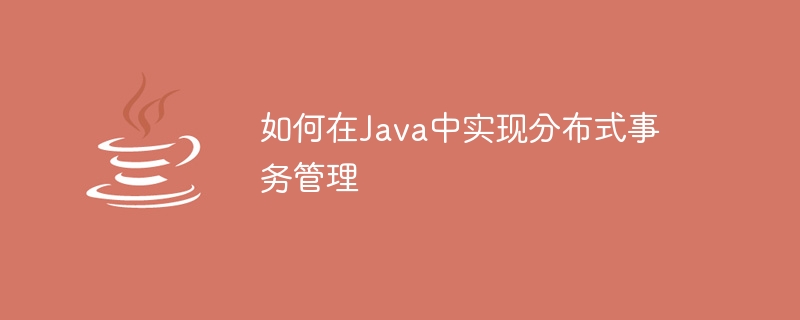

How to implement distributed transaction management in Java
Introduction:
In the development process of distributed systems, due to the autonomy and autonomy between various services Data distribution leads to complexity of transaction management. In order to ensure the data consistency and reliability of distributed systems, we need to ensure the consistency of transaction operations between various subsystems through distributed transaction management. This article will introduce how to implement distributed transaction management in Java and provide specific code examples.
1. What is distributed transaction management:
Distributed transaction management refers to a set of atomic operations that operate multiple transaction resources in a distributed system. To put it simply, multiple services participate in a transaction at the same time, and either all succeed or all fail to ensure data consistency.
2. Commonly used distributed transaction management solutions in Java:
3. Use JTA to implement distributed transaction management:
JTA is a set of standard APIs for distributed transaction management, which can be used for applications in JavaEE or for independent applications. Java application. The following is a specific example code for using JTA to implement distributed transaction management in Java.
//Import required dependencies
import javax.transaction.*;
import javax.transaction.xa.*;
public class DistributedTransaction {
public static void main(String[] args) throws SystemException, NotSupportedException, HeuristicRollbackException, HeuristicMixedException, RollbackException{
// 初始化全局事务管理器
UserTransactionManager tm = new UserTransactionManager();
tm.setTransactionTimeout(300); // 设置事务超时时间为300秒
UserTransaction ut = new UserTransactionImp();
// 开启全局事务
ut.begin();
try {
// 执行业务操作1
doBusiness1();
// 执行业务操作2
doBusiness2();
// 提交事务
ut.commit();
} catch (Exception e) {
// 回滚事务
ut.rollback();
}
}
// 业务操作1
public static void doBusiness1() {
// 实现具体的业务逻辑
}
// 业务操作2
public static void doBusiness2() {
// 实现具体的业务逻辑
}}
The above sample code demonstrates how to implement distributed transaction management through JTA. When using JTA, we need to manually open and submit transactions, and perform specific business operations in the transaction. If an exception occurs in any step of the business operation, we need to manually roll back the transaction.
4. Summary:
Distributed transaction management is crucial to ensuring the data consistency and reliability of distributed systems. There are many solutions to implement distributed transaction management in Java, such as JTA and Seata. This article describes how to use JTA to implement distributed transaction management in Java and provides specific code examples. Readers can choose a distributed transaction management solution that suits them based on actual needs and practice based on the sample code.
The above is the detailed content of How to implement distributed transaction management in Java. For more information, please follow other related articles on the PHP Chinese website!
 How to use fit function in Python
How to use fit function in Python
 How to use the atom editor
How to use the atom editor
 What are the main differences between linux and windows
What are the main differences between linux and windows
 How to open html files on ipad
How to open html files on ipad
 Ranking of the top ten digital currency exchanges
Ranking of the top ten digital currency exchanges
 Introduction to java access control modifiers
Introduction to java access control modifiers
 The role of int() function in python
The role of int() function in python
 The difference between wlan and wifi
The difference between wlan and wifi




